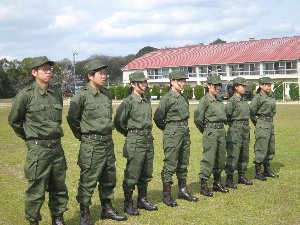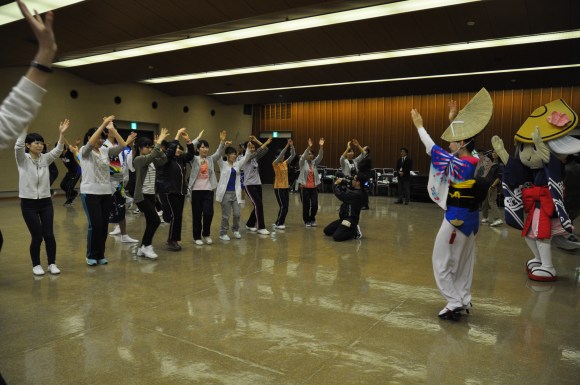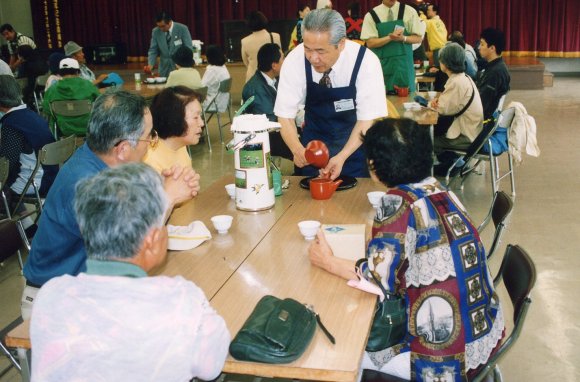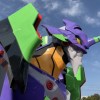
There appears to be a generational shift in the workforce of Japan recently. New additions to companies labelled as “monster recruits” in the media, along with a reported 30% of new employees quitting in three years, are leading organizations to look into new ways to protect their human resource investments. Many of the following training methods have been carried out for decades but have been steadily growing in popularity among Japanese companies.
■ Boot Camp

However, in addition to the grueling physical pain inflicted on new office workers they can learn valuable skills such as CPR and applying a tourniquet. It’s exactly these kinds of skills that businesses like Hokuetsu Bank, The Bank of Saga, and many, many more are looking to hone in their freshest faces.
■ Dance Camp
Some other companies take a different track with training new recruits by making them sing and dance rather than cauterize wounds or hike 13km. While sometimes this lively show is intended to simply promote team harmony some employers have deeper intentions.
Ordinarily, I’d rather have a sweaty guy in camouflage yell at me for three days straight than have to do jazz-hands while reenacting the Glee version of “Gangnam Style” given the choice. But this style of training does bring something interesting to the table: yuru-kyara.
Yuru-kyara are the fascinating costumed mascots of districts all over Japan. For the few lucky employees of Tokushima City government an annual dance class is held to learn the traditional Awa Odori (dance) alongside their own mascot Tokushii. The aim is for the city employees to become more familiar with the dance which is deeply connected to the prefecture they represent.
■ Pilgrimage Training
You might think joining baby goods maker Combi as a salesperson would be a cushy gig. At least you would until they confiscate your mobile phone and drop you deep in the mountains for three days with only a map.
Called pilgrimage training, it is meant to focus a new recruit’s mind on a single goal (getting out of the mountain) and achieve clarity of thinking. It’s also said that walking up steep mountain paths sharpens your “human power.”
Combi’s not alone in pilgrimage training either, with reportedly over 100 companies in Japan adopting the method. Some say it’s part of a larger trend in businesses who are looking more for real-life experience than theoretical knowledge. Good to know all that money spent on university was worth it.
■ Training by App
Some companies are attempting to “speak the language” of younger recruits by providing them with a helpful app that coaches them through the proper business etiquette. The details of the app probably varies from company to company, but next time a new employee isn’t sure whether to pick their nose and wipe it on a co-workers face, they can consult their handy app.
It’s a win-win situation as companies don’t have to waste time and money on training the basics of business behavior, and the employees don’t have to endure the shame of being lectured on it. It also incorporates challenges and staff rankings for motivation.
So far, employee response to the app has been positive with one commenting, “It’s great! I don’t feel like I have to do it.”
■ Tea Time
If you’re the type who thinks long walks in the mountains and dancing with people in animal costumes is beneath you, you may want to look into a position at the Sayama City Municipal Government. This city offers its workers training in their regional specialty Sayama Tea.
During the course, workers are taught proper pouring techniques to maximize flavor. For example, did you know when pouring two cups of tea, the water should be at a higher temperature than if you were only pouring one? That’s just one of the fascinating tea facts you can learn as a city employee here.
Those are just some of the tangential training techniques used by Japanese employers to deal with a changing generation of employees. So next time you feel like getting snippy with a bank teller, just know they might be skilled in close-quarters combat. And if you ever find yourself stranded in the middle of nowhere, try to find a baby goods dealer.
Source: Naver Matome
SDF Images: Ichiban Foods
Dance Images: Suito, Tokushima
Tea Class Image: Saitama Prefecture




 Japanese people react to the outrageous behavior of “monster” new company recruits
Japanese people react to the outrageous behavior of “monster” new company recruits Japanese workers reveal the 8 most astonishing things new employees do in the workplace
Japanese workers reveal the 8 most astonishing things new employees do in the workplace Meetings and more meetings: Foreigners list the pros and cons of working at a Japanese company
Meetings and more meetings: Foreigners list the pros and cons of working at a Japanese company Five ways to piss off your older Japanese coworkers at a new job
Five ways to piss off your older Japanese coworkers at a new job New Japanese train station has no entrance or exit, only used to admire the scenery
New Japanese train station has no entrance or exit, only used to admire the scenery Top Japanese cosplayer Enako returns to Comiket after 6 years, creates mayhem with admirers
Top Japanese cosplayer Enako returns to Comiket after 6 years, creates mayhem with admirers What makes a good boss in Japan? Workers sound off in survey
What makes a good boss in Japan? Workers sound off in survey Things get heavy with the Gold Lucky Bag from Village Vanguard
Things get heavy with the Gold Lucky Bag from Village Vanguard Japanese thug wear from Birth Japan perfect for those breaking bad next year
Japanese thug wear from Birth Japan perfect for those breaking bad next year Tokyo station platform to transform into sake bar with hot drinks, hot oden, and hot kotatsu
Tokyo station platform to transform into sake bar with hot drinks, hot oden, and hot kotatsu The Purple Lucky Bag from Village Vanguard is an extra-large waste of money
The Purple Lucky Bag from Village Vanguard is an extra-large waste of money The best soba restaurant on Yakushima island, according to locals
The best soba restaurant on Yakushima island, according to locals We visit the full-scale Evangelion statue in Kyoto and particularly delight in the food tie-ins
We visit the full-scale Evangelion statue in Kyoto and particularly delight in the food tie-ins Is it rude to sing along at concerts in Japan? We ask a pro musician for his take
Is it rude to sing along at concerts in Japan? We ask a pro musician for his take Giant new nine-floor arcade opens in Tokyo, wants to welcome new and old games fans alike
Giant new nine-floor arcade opens in Tokyo, wants to welcome new and old games fans alike Starbucks Japan ready to get Year of the Horse started with adorable drinkware and plushies【Pics】
Starbucks Japan ready to get Year of the Horse started with adorable drinkware and plushies【Pics】 Japanese beef bowl chain Sukiya’s 2026 Smile Box lucky bag basically pays for itself
Japanese beef bowl chain Sukiya’s 2026 Smile Box lucky bag basically pays for itself Hayao Miyazaki says Happy New Year to Studio Ghibli fans with new art for Year of the Horse
Hayao Miyazaki says Happy New Year to Studio Ghibli fans with new art for Year of the Horse Cup Noodle tries an authentic Jiro-style ramen, but something’s not quite right
Cup Noodle tries an authentic Jiro-style ramen, but something’s not quite right The best Starbucks Japan Frappuccinos we want to drink again in 2026
The best Starbucks Japan Frappuccinos we want to drink again in 2026 We revisited Sweets Paradise after a decade to see if Japan’s dessert buffet still delivers
We revisited Sweets Paradise after a decade to see if Japan’s dessert buffet still delivers That time Seiji called JASRAC to ask why he didn’t get paid royalties for his song being on TV
That time Seiji called JASRAC to ask why he didn’t get paid royalties for his song being on TV We found possibly the quietest Japanese-style hotel in Tokyo’s bustling Shinjuku district
We found possibly the quietest Japanese-style hotel in Tokyo’s bustling Shinjuku district Pizza Hut Japan’s hot lucky bags are perfect for a New Year’s pizza party
Pizza Hut Japan’s hot lucky bags are perfect for a New Year’s pizza party Japan’s oldest largetooth sawfish in captivity back on display in Mie Prefecture
Japan’s oldest largetooth sawfish in captivity back on display in Mie Prefecture 7-Eleven Japan starts new temporary luggage storage service in over 300 branches
7-Eleven Japan starts new temporary luggage storage service in over 300 branches Disillusionment at Tsukiji’s tourist-target prices led us to a great ramen restaurant in Tokyo
Disillusionment at Tsukiji’s tourist-target prices led us to a great ramen restaurant in Tokyo Starbucks teams up with 166-year-old Kyoto doll maker for Year of the Horse decorations【Photos】
Starbucks teams up with 166-year-old Kyoto doll maker for Year of the Horse decorations【Photos】 Tokyo considering law requiring more trash cans following litter increase in heavily touristed area
Tokyo considering law requiring more trash cans following litter increase in heavily touristed area Tokyo’s Tsukiji sushi neighborhood asks tour groups to stay away for the rest of the month
Tokyo’s Tsukiji sushi neighborhood asks tour groups to stay away for the rest of the month Tokyo event lets you travel back in time, for free, to celebrate 100 years since Showa era start
Tokyo event lets you travel back in time, for free, to celebrate 100 years since Showa era start Japan may add Japanese language proficiency, lifestyle classes to permanent foreign resident requirements
Japan may add Japanese language proficiency, lifestyle classes to permanent foreign resident requirements Sanrio theme park in Japan announces plans to expand into a Sanrio resort
Sanrio theme park in Japan announces plans to expand into a Sanrio resort Stamina-destroying “Paralysis Noodles” are Tokyo’s newest over-the-top ramen innovation
Stamina-destroying “Paralysis Noodles” are Tokyo’s newest over-the-top ramen innovation Survey asks foreign tourists what bothered them in Japan, more than half gave same answer
Survey asks foreign tourists what bothered them in Japan, more than half gave same answer Japan’s human washing machines will go on sale to general public, demos to be held in Tokyo
Japan’s human washing machines will go on sale to general public, demos to be held in Tokyo Japan’s deadliest food claims more victims, but why do people keep eating it for New Year’s?
Japan’s deadliest food claims more victims, but why do people keep eating it for New Year’s? We deeply regret going into this tunnel on our walk in the mountains of Japan
We deeply regret going into this tunnel on our walk in the mountains of Japan Studio Ghibli releases Kodama forest spirits from Princess Mononoke to light up your home
Studio Ghibli releases Kodama forest spirits from Princess Mononoke to light up your home Major Japanese hotel chain says reservations via overseas booking sites may not be valid
Major Japanese hotel chain says reservations via overseas booking sites may not be valid Put sesame oil in your coffee? Japanese maker says it’s the best way to start your day【Taste test】
Put sesame oil in your coffee? Japanese maker says it’s the best way to start your day【Taste test】 No more using real katana for tourism activities, Japan’s National Police Agency says
No more using real katana for tourism activities, Japan’s National Police Agency says Starbucks Japan reveals new sakura drinkware collection, inspired by evening cherry blossoms
Starbucks Japan reveals new sakura drinkware collection, inspired by evening cherry blossoms Updated cherry blossom forecast shows extra-long sakura season for Japan this year
Updated cherry blossom forecast shows extra-long sakura season for Japan this year Bloomberg’s video makes Japanese business etiquette seem way more complicated than it really is
Bloomberg’s video makes Japanese business etiquette seem way more complicated than it really is
Leave a Reply